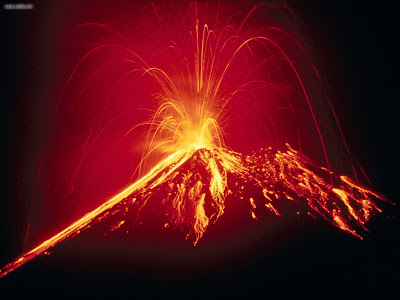Definition volcanic eruption, caused by magma sediment in the bowels of the earth, driven out by the high-pressure gas. From eruptions like these volcanoes are formed.
Eruptions
of ash and rock that brought loud burst with a radius as far as 18
miles or more, while the lava could flood the area as far as 90 km
radius. Volcanic eruptions can cause casualties and great property or
thousands of miles away and even biases affect the climate of the earth
is round. Results in the form of volcanic eruptions:
- Volcanic gases
- Lava Flow and Heat Sand and Stone
- Lava
- Ash eruption
- Heat clouds (pyroclastic)
Volcanic gases are gases released during volcanic eruptions that released include carbon monoxide (CO), Carbondioksida (CO2), Hydrogen Sulfide (H2S), sulfur dioxide (SO2) and nitrogen (NO2) which is harmful to humans.
Lava is a high-temperature liquid magma that flows to the surface through a volcanic crater. Thin lava flows away from its source is able to follow the river or the valley while the thick lava flows not far from its source.
Lahar is a danger to the public one of the tingla on the slopes of the volcano. Lahar is a flash flood on the slopes of the mountain that consists of a mixture of volcanic-sized lump of clay till. Known as the eruption and lava lava rain. Lava eruptions occurred when the volcano that has erupted crater lake, so the lake is hot water mixed with the eruption of material, while the rain lava eruptions occur due to material mixing with rain water around the peak.
Volcanic ash is a very fine material. Because wind impact can be felt hundreds of kilometers away. The impact of the ash respiratory problems, vision difficulties, pollution clean water sources, cause electrical storms, disrupt work and motor vehicle engines, damaging the roof, damaging fields, damaging infrastructure body.
Hot clouds can form pyroclastic flows, pyroclastic pyroclastic blast and fallout. Hot clouds of material flow is a major eruption cloud is hot, flowing down and eventually settle in and around the river of the valley. Blowing hot cloud is a cloud of small eruptions of hot material, blown by the wind speed reaches 90 km / h. Dropping hot cloud is a cloud of hot material large and small eruption that was brought up by the force of the eruption. Large material would fall around the peak, while the fine would fall in the tens, hundreds or even thousands of miles from the summit because of the influence of wind gusts. Hot clouds can cause severe burns to exposed body parts such as head, arms, neck or legs and also to not cause shortness of breathe.
Cause teradinya Mount erupts
- Increased volcanic seismicity
- Increased temperatures crater
- Increase in magnetic and electric waves, until the occurrence of deformation on the body mounts.
- Earth plates jostle each other and magma in the earth's crust is urging and encouraging the earth's surface and trigger the geological activity, volcanic, and tectonic.
- Due to the very high pressure, the magma pushes out (eruption) of the earth's surface as lava.
The process of mountain erupts
In some eruptions, huge clouds up into
the mountain, and the river of lava flows on the flanks of the volcano.
In another eruption, ash and red-hot coals of fire burst out of the top
of the mountain, and chunks of the hot stones thrown high into the air.
Most small eruptions have enormous power, so large that it can divide
the mountain

Basically,
a volcano is formed from magma, the molten rock deep within the earth.
Magma is formed due to the heat in the Earth's interior temperature. At a
certain depth, the temperature is very high heat so as to melt the
rocks in the earth. When the molten rock, gas dihasilkanlah then mixed
with magma. Most of the magma formed at depths of 60 to 160 km below the
earth's surface. Others are formed at depths of 24 to 48 km
Magma
containing gas, gradually rising to the surface because of its mass is
lighter than solid rocks around him. When magma rises, the magma melts
the rocks nearby, forming a large cabin at a depth of about 3 km from
the surface. Magma chamber is what is shed (reservoir) where volcanic
eruptions originating materials
Magma containing gas in magma cabin
is in a condition under heavy pressure rocks that surround it. This
pressure causes the magma erupts or melt conduit (channel) on the rocks
brittle or cracked. Magma moves out through the channel leading to the
surface. When magma close to the surface, the gas content in it
regardless. Gas and magma burst together and form a hole called the main
hole (central vent). Most of the magma and other volcanic material then
gush out through this hole. After bursts of stops, crater (crater) that
resemble bowls typically form on the top of the volcano. While there
are major holes in the bottom of the crater











